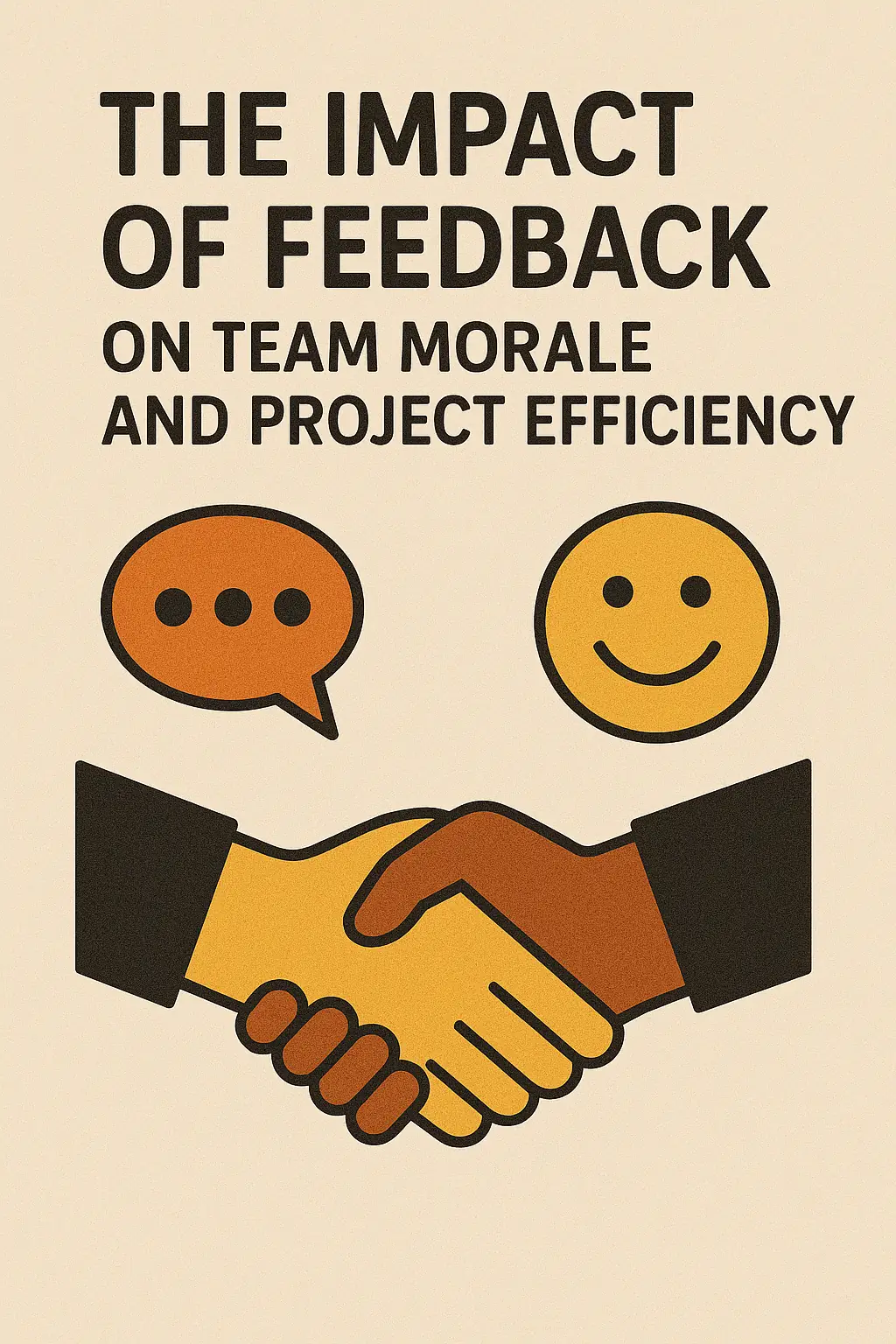Introduction
Feedback serves as a critical component that influences both team dynamics and project outcomes. Feedback, in this context, refers to the information provided to team members regarding their performance, behaviors, and contributions to a project. It encompasses both positive reinforcement for achievements and constructive criticism aimed at improvement. This dual approach not only helps in refining individual performance but also fosters a culture of continuous learning and development within the team.
The correlation between effective feedback practices and team morale is significant. When team members receive timely and constructive feedback, they are more likely to feel valued and recognized for their efforts. This recognition can lead to increased motivation, as employees understand how their work contributes to the overall success of the project. Conversely, a lack of feedback can result in feelings of uncertainty and disengagement, ultimately affecting project efficiency. Research indicates that teams that engage in regular feedback loops tend to perform better, as they can quickly address issues and adapt to changing project demands [1][2].
The purpose of this blog post is to explore the intricate relationship between feedback, team morale, and project efficiency. By examining various feedback practices and their impact on motivation, this article aims to provide valuable insights for HR professionals and project managers. Understanding these dynamics is essential for fostering a productive work environment where team members feel empowered to contribute their best efforts, thereby enhancing overall project success [3][4].
Understanding Feedback in Project Management
Feedback is a critical component of effective project management, influencing both team morale and project efficiency. By understanding the different types of feedback and their roles, project managers can foster a more motivated and engaged team. Here are some key points to consider:
Types of Feedback
- Positive Feedback: This type of feedback acknowledges and reinforces desirable behaviors and outcomes. It serves to motivate team members by recognizing their contributions and successes. For instance, comments like “You did a great job on this project” or “Your time management skills are truly valuable to the team” can boost morale and encourage continued high performance [12].
- Constructive Feedback: Constructive feedback is aimed at improvement and is delivered in a supportive manner. It highlights areas where an employee can enhance their performance while providing specific suggestions for improvement. For example, addressing unacceptable practices in a respectful way can help employees understand the necessary changes without feeling demoralized [8]. This type of feedback is essential for personal and professional growth within the team.
- Negative Feedback: While often viewed unfavorably, negative feedback can be necessary when addressing significant issues that may hinder team performance. However, it should be delivered carefully to avoid demotivating team members. The key is to focus on behaviors rather than personal attributes, ensuring that the feedback is constructive and aimed at fostering improvement [15].
Timing and Frequency of Feedback
The timing and frequency of feedback are crucial in project management. Regular feedback sessions can create a continuous loop of communication, allowing team members to adjust their performance in real-time. Here are some considerations:
- Timeliness: Feedback should be provided as close to the event as possible to ensure relevance and clarity. This immediacy helps employees understand the context and impact of their actions [11].
- Frequency: Regular feedback, rather than waiting for formal reviews, can help maintain high morale and engagement. Frequent check-ins allow project managers to address issues promptly and celebrate successes, reinforcing positive behaviors [10].
Role of Feedback in Team Dynamics and Communication
Feedback plays a vital role in shaping team dynamics and enhancing communication. It fosters an environment of openness and trust, where team members feel valued and heard. Here are some ways feedback influences team dynamics:
- Encouraging Open Communication: When feedback is delivered in a constructive manner, it encourages team members to share their thoughts and ideas, leading to a more collaborative atmosphere [9]. This open communication can enhance problem-solving and innovation within the team.
- Building Trust and Morale: Fair and unbiased feedback is more likely to be accepted and acted upon, which can significantly improve team morale. When employees perceive feedback as equitable, they are more motivated to engage and contribute positively to the project [2][3].
- Enhancing Team Performance: Effective feedback helps clarify expectations and align team members towards common goals. By understanding how their contributions impact the project, team members are more likely to stay motivated and committed to achieving success [14].
The Connection Between Feedback and Team Morale
The significance of feedback cannot be overstated. It plays a crucial role in shaping team morale and enhancing project efficiency. This section delves into the correlation between feedback practices and team motivation, drawing on studies, psychological insights, and real-life examples.
Feedback and Employee Engagement
Research has consistently shown that effective feedback is a key driver of employee engagement. According to findings from the Project Management Institute (PMI), high morale within teams is closely linked to their motivation and productivity levels. When team members receive timely and constructive feedback, they are more likely to feel valued and engaged in their work, which in turn fosters a positive work environment [5][12].
Surveys indicate that organizations that prioritize feedback mechanisms often report higher levels of employee satisfaction and commitment. For instance, companies that implement regular feedback sessions and performance reviews tend to see a marked improvement in team dynamics and overall project outcomes [8][13].
Psychological Effects of Acknowledgment and Recognition
The psychological impact of acknowledgment and recognition through feedback is profound. Positive feedback not only boosts individual confidence but also reinforces a sense of belonging within the team. When team members are recognized for their contributions, it cultivates a culture of appreciation, which is essential for maintaining high morale [6][12].
Conversely, the absence of feedback or ineffective feedback can lead to feelings of neglect and disengagement. Studies have shown that when employees do not receive constructive criticism or acknowledgment, their motivation can wane, leading to decreased productivity and morale [11][14].
Real-Life Examples of Feedback Impacting Team Spirit
Numerous organizations have witnessed the transformative power of feedback on team spirit. For example, a tech company implemented a structured feedback program that included both peer-to-peer recognition and management feedback. As a result, they observed a significant increase in team collaboration and a reduction in turnover rates. Employees reported feeling more connected to their work and colleagues, which directly contributed to improved project outcomes [9][12].
Another case involved a project team that faced challenges due to low morale. The project manager initiated regular feedback sessions, focusing on both positive reinforcement and constructive criticism. This approach not only improved individual performance but also fostered a supportive team environment, leading to enhanced project efficiency and a stronger sense of camaraderie among team members [10][12].
Feedback Practices That Enhance Project Efficiency
Effective feedback practices are essential for fostering team morale and improving project outcomes. This section explores best practices for delivering feedback, the significance of clear expectations, and the role of regular feedback loops in enhancing project adaptability.
Best Practices for Delivering Feedback
- Be Specific and Actionable: Providing clear and specific feedback is crucial. Instead of vague comments, project managers should focus on particular behaviors or outcomes that need improvement. This clarity helps team members understand what is expected and how they can enhance their performance [13].
- Choose the Right Time and Place: Timing and environment play a significant role in the effectiveness of feedback. Feedback should be delivered in a supportive setting, ideally soon after the relevant event, to ensure that the context is fresh in everyone’s mind. This approach minimizes defensiveness and encourages open dialogue [11].
- Encourage Two-Way Communication: Feedback should not be a one-sided affair. Encouraging team members to share their thoughts and concerns fosters a culture of openness. Active listening is vital; project managers should pay attention to team members’ feedback and incorporate it into future planning [4][9].
- Utilize Feedback Mechanisms: Implementing structured feedback mechanisms, such as anonymous surveys or regular check-ins, can help identify areas for improvement and enhance team performance. These tools allow team members to express their views without fear of repercussions, leading to more honest and constructive feedback [8][15].
Importance of Setting Clear Expectations and Goals
Setting clear expectations and goals is foundational to effective project management. When team members understand their roles and the project’s objectives, they are more likely to stay motivated and aligned with the project’s vision. Clear goals provide a roadmap for success, allowing team members to focus their efforts on achieving specific outcomes [2][3]. Furthermore, when expectations are communicated effectively, it reduces ambiguity and helps prevent misunderstandings that can lead to frustration and decreased morale.
Enhancing Project Adaptability and Responsiveness through Regular Feedback Loops
Regular feedback loops are instrumental in enhancing a project’s adaptability and responsiveness. By actively seeking feedback at various stages of the project, managers can identify bottlenecks and streamline workflows. This continuous feedback process allows teams to pivot quickly in response to changing circumstances or stakeholder needs, ultimately leading to more successful project outcomes [5][15].
Moreover, establishing a culture of continuous feedback encourages team members to engage more deeply with their work. When they know their input is valued and can lead to tangible changes, their motivation and commitment to the project increase significantly [14]. This dynamic not only boosts team morale but also enhances overall project efficiency.
Barriers to Effective Feedback in Project Management
Feedback is a crucial element that can significantly influence team morale and project efficiency. However, several barriers can impede the effective delivery and reception of feedback. Understanding these barriers is essential for HR professionals and project managers aiming to cultivate a feedback-friendly environment.
Cultural and Organizational Barriers
- Communication Styles: Different cultural backgrounds can lead to varying communication styles, which may affect how feedback is given and received. For instance, some cultures may prioritize directness, while others may value indirect communication. This disparity can create misunderstandings and hinder open dialogue about performance and expectations [4].
- Organizational Hierarchies: In many organizations, rigid hierarchies can stifle feedback. Team members may feel that their input is undervalued or that they lack the authority to provide constructive criticism to their superiors. This can lead to a culture where feedback is not freely exchanged, ultimately affecting team dynamics and project outcomes [7].
Fear of Negative Repercussions
- Fear of Retaliation: One of the most significant barriers to effective feedback is the fear of negative repercussions. Team members may hesitate to provide honest feedback due to concerns about how it will be received, particularly if it involves criticism of a peer or superior. This fear can lead to a lack of openness and transparency, which are vital for a healthy feedback culture [5][10].
- Impact on Team Dynamics: When team members are reluctant to share feedback, it can create an environment of mistrust and disengagement. This not only affects individual morale but can also lead to decreased overall project efficiency, as unresolved issues may fester and hinder collaboration [1][15].
Strategies to Overcome Barriers
- Encouraging Open Communication: To foster a feedback-friendly environment, project managers should actively encourage open communication. This can be achieved by creating safe spaces for discussions, where team members feel comfortable sharing their thoughts without fear of judgment or retaliation. Regular check-ins and anonymous feedback tools can also help facilitate this process [3][12].
- Training and Development: Providing training on effective feedback techniques can empower team members to give and receive feedback constructively. Workshops that focus on communication skills, emotional intelligence, and conflict resolution can equip individuals with the tools they need to navigate feedback conversations successfully [2][6].
- Modeling Feedback Behavior: Leaders should model the behavior they wish to see in their teams. By openly seeking feedback and demonstrating how to handle it constructively, project managers can set a positive example. This not only normalizes the feedback process but also shows team members that feedback is valued and essential for growth [11][15].
Case Studies: Success Stories of Feedback Implementation
The implementation of effective feedback systems has proven to be a catalyst for enhancing team morale and improving project efficiency. Below are several case studies from diverse industries that illustrate the positive impact of feedback practices on team motivation and project outcomes.
1. Leading Tech Company: Continuous Feedback Loop
A prominent technology firm adopted a continuous feedback loop, which involved real-time data collection from team members and stakeholders. This approach allowed for immediate recognition of achievements and timely constructive feedback on areas needing improvement.
- Outcomes: The implementation of this feedback system led to a significant increase in team morale, as employees felt valued and heard. The project completion rate improved by 25%, demonstrating a direct correlation between feedback practices and project success.
- Lessons Learned: The key takeaway from this case is the importance of real-time feedback. By fostering an environment where team members can share insights and receive immediate responses, organizations can enhance engagement and productivity [7].
2. Retail Industry: Structured Feedback Sessions
A major retail chain introduced structured feedback sessions as part of their project management strategy. These sessions were held bi-weekly and focused on discussing project progress, challenges, and individual contributions.
- Outcomes: The structured approach not only improved communication among team members but also boosted morale, as employees appreciated the opportunity to voice their opinions and receive recognition for their efforts. The company reported a 30% increase in employee satisfaction scores and a notable reduction in project delays.
- Lessons Learned: Regularly scheduled feedback sessions can create a culture of openness and trust, which is essential for team cohesion and project success. This structured format can be easily adapted by other organizations seeking to enhance their feedback practices [10].
3. Healthcare Sector: Peer Feedback Initiatives
In a healthcare organization, a peer feedback initiative was launched to encourage team members to provide constructive feedback to one another. This initiative was designed to promote collaboration and improve patient care outcomes.
- Outcomes: The initiative resulted in a 40% improvement in team collaboration metrics and a 20% increase in patient satisfaction ratings. Team members reported feeling more motivated and engaged, as they were actively involved in each other’s professional development.
- Lessons Learned: Peer feedback can be a powerful tool for enhancing team dynamics. By empowering team members to support one another, organizations can foster a more collaborative environment that drives both morale and efficiency [15].
4. Financial Services: Feedback-Driven Performance Reviews
A financial services firm revamped its performance review process to incorporate ongoing feedback rather than relying solely on annual evaluations. This shift allowed managers to provide continuous support and guidance to their teams.
- Outcomes: The new feedback-driven approach led to a 50% reduction in employee turnover and a marked improvement in project delivery timelines. Employees reported feeling more aligned with organizational goals and more motivated to contribute to team success.
- Lessons Learned: Transitioning from traditional performance reviews to a continuous feedback model can significantly enhance employee engagement and retention. This strategy is particularly effective in fast-paced industries where adaptability is crucial [6].
Conclusion
The significance of feedback cannot be overstated. It serves as a cornerstone for enhancing both team morale and project efficiency. By fostering an environment where feedback is not only welcomed but actively sought, project managers can cultivate a culture of continuous improvement and engagement.
Key insights from recent research highlight the following:
- Enhancement of Team Morale: Regular and constructive feedback boosts motivation among team members, reinforcing desirable behaviors and celebrating achievements. This positive reinforcement cultivates a culture of appreciation, which is essential for maintaining high morale within the team [5][11].
- Improvement in Project Efficiency: Effective feedback practices lead to higher productivity levels. When employees feel valued and understood, they are more likely to be engaged and committed to their work, ultimately driving project success [8][9].
- Assessment and Improvement of Feedback Practices: HR professionals and project managers are encouraged to regularly assess their feedback mechanisms. Understanding the specific needs of team members and tailoring feedback accordingly can significantly enhance its effectiveness. Key components such as timeliness, specificity, and constructiveness should be prioritized to ensure that feedback is impactful [10][12].
In conclusion, the correlation between effective feedback practices and team motivation is clear. By prioritizing feedback, organizations can create a supportive environment that enhances both morale and efficiency, paving the way for sustained success in project management.
Find out more about Shaun Stoltz https://www.shaunstoltz.com/about/.
This post was written by an AI and reviewed/edited by a human.



